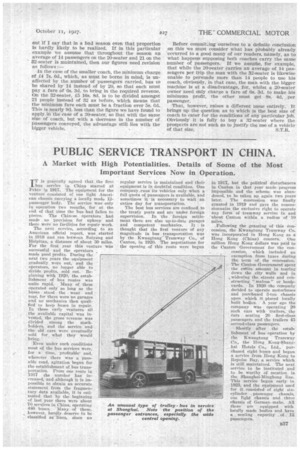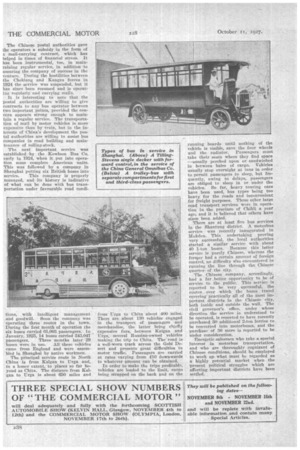PUBLIC SERVICE TRANSPORT IN CHINA.
Page 63

Page 64

If you've noticed an error in this article please click here to report it so we can fix it.
A Market with High Potentialities. Details of Some of the Most Important Services Now in Operation.
IT is generally agreed that the first bus serVice in China started at Pekin in 1917. The equipment for the venture consisted of one light American chassis carrying a locally made 12passenger body. The service was only in operation two months, for at the end of that time the bus had fallen to pieces. The Chinese operators had made • no provision for upkeep and there were no ficilities for repair work.
The next service, according to an American official report, was started in 1919 and ran between Suiyang and Ilsipitau, a distance of about 30 miles. For the first year this venture was successful and the operators made good profits. During the next two years the equipment gradually wore out, and the operators, no longer able to divide profits, sold out. Beginning with 1920, the establishment of bus routes was quite rapid. Many of them operated only so long as the buses stood. the wear and tear, for there were no garages RBA no mechanics then
quali
fied to keep buses in repair. In. these early ventures all the available capital was invested, the gross revenue was divided among the stockholders, and the service and the old cars were eventually sold for what they .would
bring,' '
Even under such conditions most of the bus services were, for a time, profitable' and, wherever there was a passable road, agitation began for the establishment of. bus transportation. From one route in 1917 the number has increased, and although it is impossible to obtain an accurate statement from the fragmentary data available, it is estimated that by the beginniug of last year there were about 70 services in China, operating 480 buses. Many of these, however, hardly. deserve to be classified as lines, since no regular service is maintained and their equipment is in doubtful condition. One compan-y,runs its vehicles only when a full quota of passengers is available, and sometimes it is necessary to wait an entire day . for transportation.
The best bus services are confined to the treaty ports and are under foreign supervision. In the foreign settlement there are also up-to-date garages and competent mechanics. It is thought that the first venture of any magnitude in bus transportation was by the Kwangtung,Tramway Co., of Canton, in 1920. The negotiations for the opening of this route were begun in 1917, but the political disturbances in Canton in that year made progress impossible and the scheme was abandoned, to be taken up again two years later. The concession was finally granted in 1919 and gave the concessionnaire the exclusive right to operate any form of tramway service in and 'about Canton within a radius of 10 ,Following the granting of this eoncession, the Kwangtung Tramway Co. was incorporated in Hong Kong as a Hong Kong (China) concern. One million Hong Kong dollars was paid to the Canton Government' for the concession, which included an exemption from taxes during the term of the concession. The Canton Government spent the entire amount in tearing down the city walls mid in widening the streets and constructing " maloos " or boulevards. In 1920 the compah decided to operate motorbuses and purchased 3-ton _ chassis upon which it placed locally built bodies. A year ago the company was operating 20 such ears with trailers, • the ears seating 20 first-class passengers and the trailers 43 second-class passengers.
Shortly after the establishment of bus operation by the Kwangtung Tramway Co., the HOng, Kong-Shanghai Hotels Co., Ltd., purchased eight buses and began a service from. Hong Kong to Repulse Bay, a service which is still maintained.. The next service to be instituted and to be worthy. of mention is the, Shanghai-Tvlinghong line.. -This service began early in 1923, and the equipment used for it consisted of eight sixcylinder passenger chassis, one light chassis and three chassis of German-make. All these are equipped with locally made bodies and have a seating • capacity of 12
• passengers. The Chinese postal authorities gave the operators a subsidy in the form of a mail-carrying contract, which has helped in times of financial stress. It has been instrumental, too, in maintaining regular service, in addition• to assuring the company of success in the venture. During the hostilities between the Chekiang and Kangsu forces in 1924 the service was suspended, but it has since been resumed and is operatieg regularly and carrying mails.
It is interesting to note that the postal authorities are willing to give contracts to any bus operator between two important points, provided the concern appears strong enough to maintain a regular service. The transportation of mail by motor vehicles is more expensive than by train, but in the interests of China's development the postal authorities are willing to assist bus companies in road building and maintenance a rolling-stock.
The next important service was established -by the Kowloon Bus Co. early in 1924, when it put into operation some complete American units. This was followed by a company in Shanghai putting six British buses into service. This company is properly managed, and its history is indicative of what can be done with bus transportation under favourable road condi tions, with intelligent management and goodwill. Soon the company was operating three routes in the town. During the first month of operation the six buses carried 61,003 passengers. In January, 1925, 14 buses carried 343,047 passengers. Three months later 29 buses were in use. All these vehicles came from England and were assembled in Shanghai by native workmen.
The principal service route in North China is from Kalgan to Urga and, to a lesser extent, to places so far beyond as Chita. The distance from Kalgan to Urga is about 650 miles and
from Urga to Chita about 400 miles. There are about 130 vehicles engaged in the transport of passengers and merchandise, the latter being chiefly expensive furs, between Kalgan and Urga, several Russian-owned vehicles making the trip to Chita. The road is a well-worn track across the Gobi Desert and presents great difficulties to motor traffic. Passengers are carried at rates varying from £10 downwards to whatever amount can be obtained.
In order to make the trips profitable, vehicles are loaded to the limit, cargo being strapped on the back and on the running boards until nothing of the vehicle is visible, save the four wheels and the radiator. Passengers must take their seats where they find space --usually perched upon or sandwiched in between bales of cargo. Vehicles usually stop overnight at inns in order to permit passengers to sleep, but frequently, owing to delays, passengers are obliged to sleep in or under the vehicles. So far, heavy touring cars have been used, bus types being too heavy for the roads and inconvenient for freight purposes. Three other large road transport services were in operation in the province of Chihli a year ago, and it is believed that others have since been added.
There are at least five bus services in the Shantung district. A motorbus service was recently inaugurated in Mukden. This undertaking proving very successful, the local authorities started a similar service with about 40 1-ton buses. Because this latter service is purely Chinese, whereas the former had a certain amount of foreign control, no difficulty -Was encountered in running the line through the Chinese quarter of the city.
The Chinese company, accordingly, had a far better opportunity to be of service to the public. This service is reported to be very successful, the routes over which the buses travel covering practically all of the most important districts in the Chinese city, both inside and Outside the wall. The civil governor's office, under whose direction the service is understood to be operated. is reported to have recently purchased 30 additional 2-ton lorries to be converted into motorbuses and the purchase of 20 more is reported to be under consideration.
Energetic salesmen who take a special interest in motorbus transportation, and who are thoroughly cognizant of Chinese conditions, should be employed to work up what must be regarded as a highly potential market when the -present political struggles which are affecting important districts have been settled.




















































































































